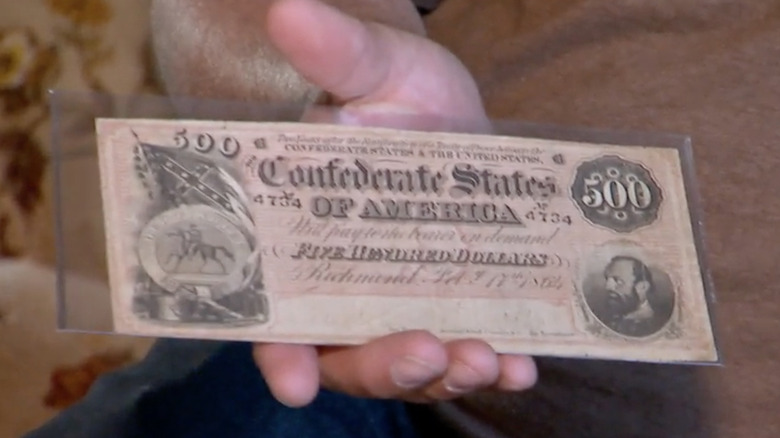The Civil War Cash That Cost American Pickers $1,000
If you only ever watched "American Pickers" and "Pawn Stars," one could be forgiven for thinking that the only outcome of all wars of centuries' past was the production of tons of antiques and collectibles (of course, there were other, more important side effects). Various forms of war booty have appeared on the two History series, from an American Civil War-era rifle that cost the Pickers $2,250 to the World War I-era flag that sold for thousands on "Pawn Stars."
In Season 4 of "American Pickers," the Gettysburg Museum of History asks Mike and Frank to hunt down a number of rare Civil War items for display in their museum, which focuses largely on the Civil War as a result of its location, the site of a major Civil War battle in 1863 (via Gettysburg Museum of History). While Mike and Frank take the opportunity to gather a number of interesting Civil War-era collectibles, their interest is piqued by some Confederate cash.
As with many items featured on "American Pickers," understanding the importance of the items in front of Mike and Frank requires a short history lesson. At the beginning of the war, 11 Southern states seceded from the Union and formed the Confederacy, resulting in two separate countries. While the Confederacy was dissolved at the end of the Civil War, the four years of war not only resulted in 750,000 deaths (via BBC News), but also a large supply of suddenly worthless money produced by the Confederate government.
Confederate money is extremely rare now
"So, if it's worthless, why do Mike and Frank pay $1,000 for it?" you might ask. While Confederate money was considered to have no value once the Confederacy was dissolved, the bills have changed in value significantly in the 156 years since the end of the Civil War. As a result of their rarity today, they are seen as antiques, not legal tender (via Investopedia). However, while they are certainly not spendable at your local convenience store, they are worth a substantial sum all the same.
During their search for Civil War memorabilia, Mike and Frank are offered a number of Confederate bills and quickly zero in on one $500 bill that has a picture of Confederate General Stonewall Jackson in the lower right corner, and a $10 bill marked "counterfeit." Prior to sale, the seller notes that he is unsure if the $10 bill was legitimate Confederate currency that was marked counterfeit by the Union or, indeed, an entirely fraudulent bill. Such an oddity makes the bill even more rare as an antique.
The owner asks $800 for the "counterfeit" bill and $450 for the Stonewall Jackson bill. After noting that the bills will go into a museum, the owner decides to cut Mike and Frank a deal for $1,000 for both of them. They gladly accept and shake hands to finalize the deal.

